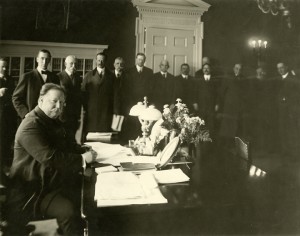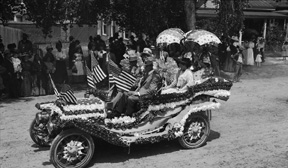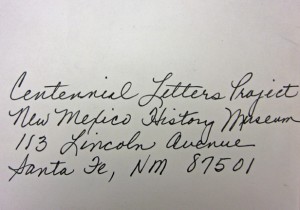 It’s official: Governor Susana Martinez has declared Thursday, May 3, “New Mexico Statehood History Day.” Thursday, not so coincidentally, happens to be the day the New Mexico History Museum and the Historical Society of New Mexico kick off three days of learning about statehood.
It’s official: Governor Susana Martinez has declared Thursday, May 3, “New Mexico Statehood History Day.” Thursday, not so coincidentally, happens to be the day the New Mexico History Museum and the Historical Society of New Mexico kick off three days of learning about statehood.
In her proclamation, Governor Martinez said:
Whereas, the year 2012 marks the Centennial of New Mexico becoming the 47th state of the union on January 6, 1912; and
Whereas, New Mexico’s millennia of cultural traditions and centuries of recorded history, beginning with the first Spanish entrada in 1540 and continuing through Spanish Colonial, Mexican, Territorial, and statehood periods, are as rich and deep as any; and
Whereas, New Mexico’s long path to statehood, beginning with being named a territory of the United States in 1850, involved the perseverance oaf many dedicated citizens over many decades; and
Whereas, the study and understanding of our unique history provides a base for New Mexicans to better prepare for the future;
Now, therefore I, Susana Martinez, governor of the state of New Mexico, do hereby proclaim the 3rd day of May 2012 as “New Mexico Statehood History Day” throughout the state of New Mexico.
The best way to honor Statehood History Day, in our eyes, is by visiting the state History Museum. Admission is free to everyone on Thursday and you can pop into any or all of the lectures at our Centennial Symposium. On Friday and Saturday, the Historical Society holds its annual conference at the Santa Fe Convention Center, and this year, the discussions are focused on statehood. (Click on the link for details on how to register.)
Topics will range from traditional foods in Native American communities to land-grant studies, Western characters like Kit Carson and Wyatt Earp, and controversial New Mexico politicos such as Thomas Benton Catron, Bronson Cutting, and New Mexico’s first Territorial Governor (and possible U.S. spy) James S. Calhoun. The conference’s 24 sessions and nearly 70 presentations include:
- “Juan Dominguez de Mendoza: Soldier and Frontiersman of 17th-Century New Mexico,” by historians Marc Simmons and José Antonio Esquibel.
- “The Changing Character of New Mexico Statehood as Reflected by the Santa Fe Fiesta Celebration,” by Andrew Lovato, assistant professor of speech communications at Santa Fe Community College.
- “Butch Cassidy in New Mexico: His Winning Ways, Dancing Feet, and Postmortem Return,” by free-lance writer Nancy Coggeshall.
- “U.S. Army Nurses at Fort Bayard,” by Cecilia Jensen Bell, a researcher with the Fort Bayard Historical Preservation Society.
- “La Matanza: Conserving Identity through Food in Los Lunas,” by Daniel Valverde, an anthropology student at New Mexico State University.
“The research that these scholars have accomplished is truly impressive,” said Dr. Frances Levine, director of the New Mexico History Museum. “Visitors can start their weekend history immersion by seeing the maps, paintings, photographs and artifacts that we use in our main exhibit, Telling New Mexico: Stories from Then and Now. If you’re not already a fan of history, the symposium and conference will make you one.”
Founded in 1859, the Historical Society of New Mexico is the oldest historical society in the West. Its collections were incorporated into the original Museum of New Mexico, created in 1909 in the Palace of the Governors, and today represent an important part of the New Mexico History Museum’s holdings. The society’s photographs, documents and books, collected from 1885 on, became the core of the museum’s Fray Angélico Chávez History Library and the Photo Archives at the Palace of the Governors. The Society began its annual conferences in 1974, and also publishes award-winning papers and news of history around the state in La Crónica de Nuevo México.
Image above: Dignitaries join U.S. President William H. Taft as he signs New Mexico into statehood in Washington, D.C., on Jan. 6, 1912. Photo by Harris and Ewing. Palace of the Governors Photo Archives 89760.





